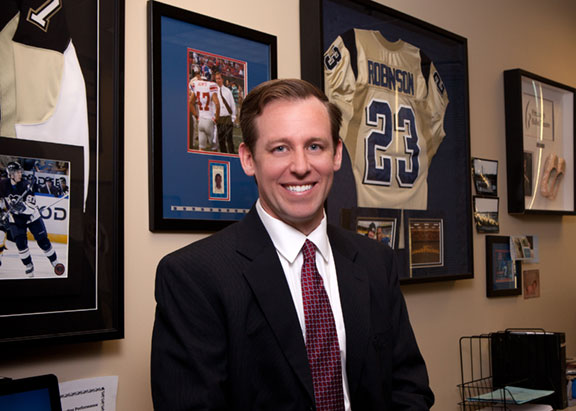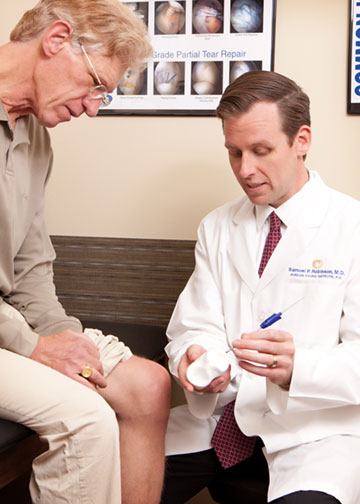…from the NFL to the community tennis court, helping active adults stay active – at every age
Promotional Feature
 Americans are living and staying active longer, participating in sports and other vigorous activities well into their middle and later years. When they begin to encounter pain and stiffness, they may also begin to avoid physical activity because they have – or because they fear – increasing pain. Golf clubs are relegated to the closet, gardening tools to the shed, evening walks are curtailed – and thus quality of life diminished.
Americans are living and staying active longer, participating in sports and other vigorous activities well into their middle and later years. When they begin to encounter pain and stiffness, they may also begin to avoid physical activity because they have – or because they fear – increasing pain. Golf clubs are relegated to the closet, gardening tools to the shed, evening walks are curtailed – and thus quality of life diminished.
Rather than alleviating their pain, many people are putting themselves at risk for even more significant medical problems: cardiovascular disease, diabetes, hypertension, depression and anxiety. Fear of the surgeon’s scalpel keeps many from seeking medical care.
Surgery is far from a patient’s only option. Orthopedist Dr. Samuel P. Robinson has the most current specialized training, knowledge and experience to relieve or entirely eliminate joint pain – both in and outside of the operating room.
He was drawn to medicine on an Operation Smile trip to Nicaragua, where he saw the power of surgery to literally change someone’s life for the better. He earned his medical degree at Northwestern University’s Feinberg School of Medicine, where he was attracted to the functional outcomes in orthopedics. He served his internship at New York Presbyterian Hospital-Weill Cornell Medical Center; and completed his residency in orthopedics at New York’s prestigious Hospital for Special Surgery. During that time, he served as Assistant Team Physician for the New York Giants and St. John’s University’s basketball team.
 During his fellowship in sports medicine at the University of Pittsburgh, he spent a year learning innovative complex and technical orthopedic procedures from one of the pioneers in the field: Dr. Freddie Fu, Chairman of the Department of Orthopaedic Surgery.
During his fellowship in sports medicine at the University of Pittsburgh, he spent a year learning innovative complex and technical orthopedic procedures from one of the pioneers in the field: Dr. Freddie Fu, Chairman of the Department of Orthopaedic Surgery.
Under Dr. Fu’s tutelage, Dr. Robinson took care of the NHL’s Pittsburgh Penguins, the University’s football team and the Pittsburgh Ballet Theatre. “Football players are big and tight,” he says, “and often sustain acute traumatic injuries. The ballet athletes are amazingly flexible, and have more chronic, repetitive use injuries. They may have had different injuries, but their injuries were no less painful and constituted no less a career-ending threat. I was treating both ends of the athletic spectrum.”
Whenever these elite athletes sustained injuries – as they invariably did – it was his job to get them back on the field of play, or the stage, as quickly and as safely as possible, without debilitating, season-ending surgery. This meant treating trauma from high impact collisions or falls, ligament tears, shoulder dislocations and a host of other injuries. It was his job to preserve their joints, and to get these elite athletes back in the game – a job for which he had extensively trained.
Despite offers to stay on as a permanent member of the Pittsburgh Penguins’ medical team, Dr. Robinson wanted a different life, one that included the diversity of a private practice: the opportunity to help patients of every age and all orthopedic presentations – where he could fully employ all of his specialized technical training and skills.
Today, Dr. Robinson incorporates the concepts and techniques he learned taking care of professional athletes and applies them to everyday orthopedic problems, as well as more complex presentations.
“There are solutions for all stages of orthopedic problems that don’t necessarily require surgery,” he says. “We have great success with injections, physical therapy and braces. It depends on the patient and the severity of the problem. I spend a lot of time trying to help people avoid surgery.”
But when his patients cannot or no longer respond to nonsurgical treatment, Dr. Robinson makes sure they understand every aspect of their procedure before he performs it – including both risk and benefit. “These are highly technical and complicated surgeries,” he explains, “so I want to be sure my patients understand exactly what they can expect when their knee or shoulder needs surgery.”
If these patients have no other options, joint replacement can be entirely appropriate, Dr. Robinson says. Today’s joint replacements can last 20 years or longer, and in the right patient, the procedure rarely has to be redone.
“But,” he says, “today I’m seeing active 40 to 55-year olds who want to stay active, patients who are developing micro-cracks in the subchondral bone, similar to stress fractures, secondary to osteoarthritis. They’re in significant pain, but they’re not ready for a knee replacement, either practically or emotionally.” Similarly, Dr. Robinson sees 65-year olds who would be candidates for knee replacement, but other medical conditions put them at increased risk for surgery.
Previously, orthopedics had little to offer these “in-between” patients who presented with significant pain, but for whom joint replacement wasn’t an option.
For Dr. Robinson’s knee patients, that changed in 2014, when he perfected a new, minimally invasive procedure called subchondroplasty, which involves standard arthroscopy to debride intra-articular pathology, as well as fluoroscopically guided insertion of a bone substitute made of calcium phosphate, which sets in 10 minutes, mimics the strength of bone, and is gradually replaced with natural bone over 12 to 24 months. “It’s a new and very exciting option for these patients,” he says. “The biggest advantage – of the many – is that it preserves the patient’s natural joint and allows a quick recovery time.”
His patients report significant pain relief within a few weeks. “Subchondroplasty isn’t a substitute for knee replacement,” Dr. Robinson cautions, “and it’s not curing the arthritis. But it has been shown to relieve pain and increase function for as much as five years; and importantly, it doesn’t limit the patient’s future treatment options, whether partial or total knee replacement.”
Just as with his knee patients, Dr. Robinson often treats shoulder pain successfully without surgery: with injections, therapy or medications, as appropriate. When surgery is required, he can frequently preserve the shoulder joint by making many repairs arthroscopically. When the joint can no longer be preserved, a standard shoulder replacement is done; or in cases of severe damage to the joint and rotator cuff, he performs the innovative reverse total shoulder replacement, which reverses the ball and socket function within the shoulder.
Dr. Robinson helped pioneer the routine use of regional anesthesia for shoulder surgery patients in Hampton Roads, a tremendous benefit for patients both during and after their procedure. Because regional anesthesia provides excellent pain relief, less anesthesia is required during surgery and less medication required following the procedure. This eliminates or reduces the complications associated with anesthesia and post-operative pain medications and helps with recovery.
Understanding the Goal Drives the Treatment.
“When I was treating professional athletes, I understood their goals,” Dr. Robinson says. “They wanted to be back playing the sport they loved. It’s the same with today’s patients: they may not be elite athletes, but their pain is no less real, and their desire to return to what they love is no less intense.”
Dr. Robinson’s goal? “I want to do everything I can to help people get where they want to be, in a way that minimizes risk and gets them the best possible result. That means really understanding what they want to accomplish.” He takes the time to talk – and to listen – to them, to find out what they’ve been doing, what they can no longer do, and what their specific goals are. And whether those goals be retrieving the golf clubs, kneeling in the garden or just taking that evening stroll, he has the tools and the skills to get them back in their game.
“It’s so exciting to have something to offer all of these patients,” he says. “I always knew that if I could get LeSean McCoy back on the gridiron, I could get my everyday patients back on their field of play, wherever that might be.”
Dr. Robinson practices with Jordan-Young Institute, 5716 Cleveland Street, Virginia Beach. 757.490.4802. www.jordan-younginstitute.com. www.facebook.com/srobinson.md.

